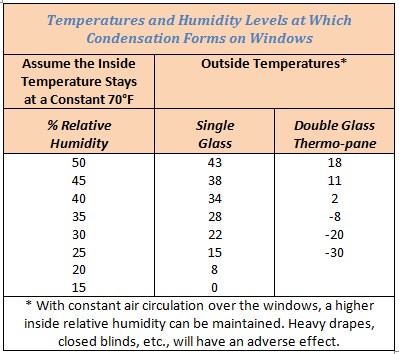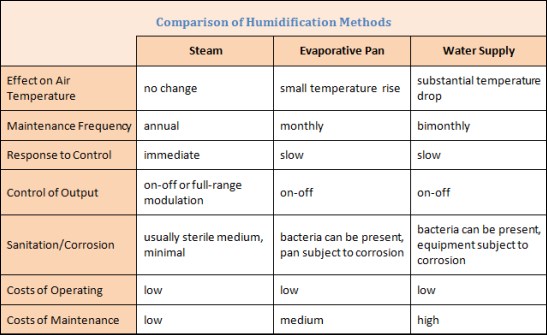As a facility manager, you need to understand how humidity levels affect human health and comfort as well as the building structure. Condensation on windows usually indicates excessive relative humidity (RH). The same condensation you see on windows is most likely inside walls and in other places as well. Therefore, it is necessary to set and maintain safe indoor RH levels to avoid compromising the condition of the building. Not sure about the correct RH for your building? The following table can help:

Effects of Humidity
Materials swell and shrink as they take on and lose water. Humidity therefore affects the dimensions and weight of materials. Wood, leather, paper, cloth, carpet, and rugs all contain water in quantities that vary with the surrounding humidity. For example, at 60 percent RH, a cubic foot of dry wood weighs 30 pounds and holds 3 pints of water. If the RH were lowered to 10 percent, the wood would hold only 1 pint of water and would be lighter. The effects of this constantly changing moisture content can shrink joists and studs, crack plaster, separate wood paneling, and dry out furniture, art, and books.
Air inside a building tends to be dry during cold weather because the RH drops as the air is heated. Static electricity, which is caused by friction, increases proportionally with the speed. Because machinery runs at high speeds, dry air causes problems. Without sufficient humidity to stop static electricity, high-speed machinery will not be able to function efficiently.
In the printing industry, static electricity must be kept down to a level that prevents paper from jamming the high-speed presses. Sparks caused by static electricity are dangerous in areas containing flammable materials.
Three systems are available for adding humidity to building air.
- Steam humidification
- Evaporative pan humidification
- Water spray humidification
Steam Humidification
When steam (water in its gas state) mixes with cooler air, it becomes water vapor. Steam humidification is basically an isothermal process; there is practically no change in the dry-bulb temperature of the humidified air. (The dry-bulb temperature is the temperature of air as measured by an ordinary thermometer; a wet-bulb temperature, on the other hand, also takes into consideration the moisture content of the air.)
Steam humidification units require minimal maintenance. The high temperatures in steam humidification make it virtually a sterile medium. Assuming boiler makeup water is of satisfactory quality and no condensation is dripping in the ducts, no bacteria or odors should be disseminated with the steam. Some codes, however, do not allow direct injection of steam into the airstream for biological reasons.
Evaporative Pan Humidification
In evaporative pan humidification, air flows across the surface of heated water in the pan and absorbs water vapor. As with steam humidification, evaporative pan humidification is an isothermal process and does not change the dry-bulb temperature. Evaporative pan humidifiers can sustain bacteria colonies and distribute them. High water temperatures, water treatment, and regular cleaning and flushing will help eliminate this. Evaporative pan units are subject to corrosion and deterioration depending on the materials they are constructed of, the frequency of cleaning, and the mineral content of the water.
Water Spray Humidification
Water spray humidification disperses water as a fine mist into the airstream, where it evaporates. The heat of evaporation reduces the sensible heat of the air by 970 Btu per pound of water, reducing the dry-bulb temperature accordingly. Maintenance requirements depend on mineral content of the water. With water spray equipment, minerals dispersed in the mist settle out as dust when the droplets evaporate. Spray nozzles can become clogged with mineral deposits and require cleaning to maintain capacity. Water spray systems can distribute large amounts of bacteria and cause odors.
The following table compares the three humidification methods discussed above:

By being more aware of the effects that humidity has on building systems and materials, as well as human health and performance, you can provide a healthier, more productive workplace environment.
This article is excerpted from the BOMI International course Air Handling, Water Treatment, and Plumbing Systems, part of the SMA® and SMT® designation programs. Sign up for this or other BOMI International classes today and begin to work toward your professional designation. More information regarding this course and BOMI International’s education programs is available by calling 1-800-235-2664. Visit BOMI International’s website, www.bomi.org.